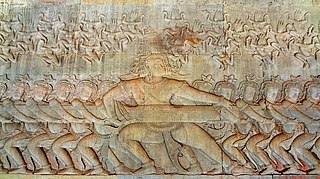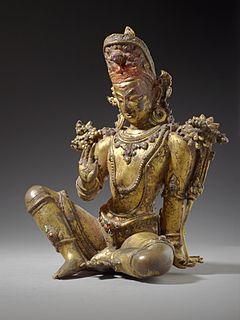
Asuras are a class of beings in Indian religions. They are described as power-seeking clans related to the more benevolent Devas in Hinduism. In its Buddhist context, the word is sometimes translated "titan, "demigod", or "antigod".
Hindu deities are the gods and goddesses in Hinduism. The terms and epithets for deity within the diverse traditions of Hinduism vary, and include Deva, Devi, Ishvara, Ishvari, Bhagavān and Bhagavati.

Kurma, is an avatar of the Hindu god Vishnu. Originating in Vedic literature such as the YajurVeda as being synonymous with the Saptarishi called Kasyapa, Kurma is most commonly associated in post-Vedic literature such as the Puranas with the legend of the churning of the Ocean of Milk, referred to as the Samudra manthan. Also synonymous with Akupara, the world-turtle supporting the Earth, Kurma is listed as the second incarnation of the Dashavatara, the ten principal avatars of Vishnu.

Deva means "heavenly, divine, anything of excellence", and is also one of the terms for a deity in Hinduism. Deva is a masculine term; the feminine equivalent is Devi.

A daeva is a Zoroastrian supernatural entity with disagreeable characteristics. In the Gathas, the oldest texts of the Zoroastrian canon, the daevas are "gods that are rejected". This meaning is – subject to interpretation – perhaps also evident in the Old Persian "daiva inscription" of the 5th century BCE. In the Younger Avesta, the daevas are divinities that promote chaos and disorder. In later tradition and folklore, the dēws are personifications of every imaginable evil.

The Samudra Manthana is one of the best-known episodes in the Hindu philosophy narrated in the Bhagavata Purana, in the Mahabharata and in the Vishnu Purana. The Samudra Manthana explains the origin of Amrita.

An asura in Buddhism is a demigod or titan of the Kāmadhātu. They are described as having three heads with three faces each and either four or six arms.
The Kālakeyas or Kālakhañjas are a class of Asura in Buddhist and Hindu mythology. They were a powerful, ferocious and cruel clan of the Dānavas.

Asura is a genus of moths in the subfamily Arctiinae erected by Francis Walker in 1854.

Asura's Wrath is an action video game developed by CyberConnect2 and published by Capcom. Asura's Wrath was first announced at the Tokyo Game Show in 2010, and was released worldwide in February 2012. The game is playable on PlayStation 3, Xbox 360, Xbox One & Xbox Series X/S via 360 backwards compatibility, and the PlayStation 4 and PC via PlayStation Now.
Asura strigipennis is a moth of the family Erebidae. It was described by Gottlieb August Wilhelm Herrich-Schäffer in 1914. It is found on Java, Sumatra and in China, Taiwan and India.
Asura avernalis is a moth of the family Erebidae. It is found on the Solomon Islands and Bougainville Island.
Asura floccosa is a moth of the family Erebidae. It is found in India and Sri Lanka.
Asura inconspicua is a moth of the family Erebidae first described by Frederic Moore in 1878. It is found in the Nilgiri Mountains of India.
Asura likiangensis is a moth of the family Erebidae. It is found in China.
Asura unipuncta is a moth of the family Erebidae. It is found in China.
Asura quadrilineata is a moth of the family Erebidae. It is found on Aru and in Australia.

Cyme sexualis is a moth of the subfamily Arctiinae first described by Felder in 1864. It is found on Ambon, Sulawesi, the Dampier Archipelago. and in New Guinea.
Cyme basitesselata is a moth of the subfamily Arctiinae.
Pseudischnocampa nigrivena is a moth in the family Erebidae. It was described by William Schaus in 1901. It is found in Bolivia.







